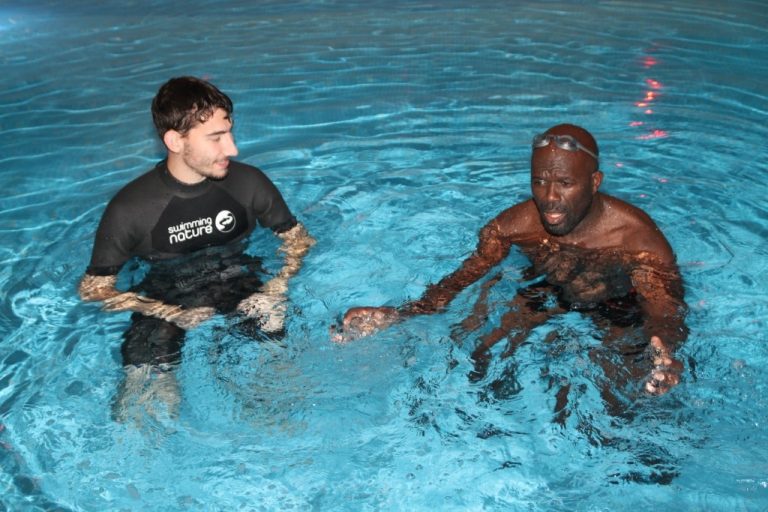 Swimming is a very impressive sport as it offers something that no other aerobic exercise does: the ability to work out your body without severe impact to your skeletal system. This is because water supports your body as you move (you automatically become lighter), whilst providing resistance to increase your muscular strength and decrease harm to your joints. Due to these benefits this attracts a variety of people to swimming.
Swimming is a very impressive sport as it offers something that no other aerobic exercise does: the ability to work out your body without severe impact to your skeletal system. This is because water supports your body as you move (you automatically become lighter), whilst providing resistance to increase your muscular strength and decrease harm to your joints. Due to these benefits this attracts a variety of people to swimming.
However, no matter what the benefits are there still seems to be quite a few people that avoid the water all together. This could be because of a bad experience in the water or an unexplained fear. Fear can be caused by many reasons such as feeling nervous in an unsettled environment or avoiding confrontation due to feelings of panic and agitation. Over time this fear may build as a mental block resulting in people avoiding swimming all together.
First you have to overcome your fear of the actual water. Once this is done you may find that you don’t even need that many swimming lessons as the anxiety would have worn of.
Here are 13 step by step directions that I have put together to change your attitude towards swimming and help improve your technique.
1. It is Never too Late!
If you feel that you are too old to start something new. Then why not start with the basics and set small goals and targets for yourself. For instance try to swim 10 meters continuously or count how many strokes it takes you to get to the other side (tells you about your rhythm and timing). Click here to have a read about our interview with James Poole who learnt to swim as an adult!
2. Don’t Overthink it!
Adults have the tendency to over analyze the technique and as a result they lose valuable time of “real” swimming. As children we are fearless willing to dive right in and try different things, jumping first and looking later. Try to remember this feeling and enjoy the water more. Remember swimming is also about having fun in the water. Don’t think- just swim.
3. Choose a Pleasant Environment and Teacher
Good communication with your swimming teacher will make you feel more comfortable in the water. You will probably be more willing to improve your skills as you will know what is expected from you.
4. Use the Right Equipment
To get the best out of your swimming lessons you need to choose the right gear to suit your body type. Choose a comfortable swimsuit and a good pair of fitted goggles. Shop around and make sure you buy swimming items that are best suited to you. Online shops include: www.swimshop.co.uk and www.sweatband.com
5. Keep Yourself Calm and Relaxed
It is very important that you keep your body stress-free while swimming. A tight, stiff body will use up more energy. So “Keep Calm And Just Keep Swimming.”
6. Don’t Just Hold Your Breath!
Carbon dioxide in the blood is raised very quickly when you do not exhale. You should inhale when your face is out of the water and exhale when your face is in the water; essentially you can breathe normally.
7. Train as Much as Possible
You can only improve on your swimming technique if you practice again and again. Set aside 2 30 minute workout sessions per week to maintain basic health and fitness levels. In a single session try stay in the pool until you have done 400 meters of swimming or 16 lengths of a 25 meter pool at a medium to high significant pace. If you need some help improving your swimming ability, why not get yourself booked in for some lessons by clicking here.
8. Try to Learn the Strokes Step by Step
If you are a beginner try not to focus too much on swimming a full stroke, instead focus on breathing and then progress to the correct body position which aids in developing kicking and lastly arms. By following these steps you’ll be swimming in no time.
9. Keep it Simple
While swimming front crawl your arms should move under the central line of your body which means under the middle of your chest and your stomach. Try to keep your elbow higher than your hand at all times.
10. Close your Fingers
You can imagine that your hands are paddles. This will help you to catch more water and increase your swimming pace.
11. Forget Cycling Movements in the Water
One of the most common mistakes is to bend your knees excessively. This can result in a bad performance in the water. So, remember the leg’ movement begins from the hips. Straight legs, floppy ankles are a great starting point.
12. Bring a Friend!
Instead of attending a swimming lesson by yourself why not bring a friend to join in on the fun. You can help each other out and even challenge one another. You can contact our friendly team who are always happy to help get you and a friend booked in.
13. Don’t Give Up!
You may not achieve your goal the first time so don’t be too hard on yourself. Try again and work on areas that you need to improve on. Ask your swimming teacher for advice, book more lessons and make sure that you maintain a healthy balanced diet to boost your energy levels and help improve your performance.
As well as being fun, swimming is a great way to keep fit and stay healthy. It is the ideal exercise to improve your physical and mental health. It might take a little while to adjust to the water but with a bit of help you can face your fear full on. Take a look at our programmes to help improve your swimming ability!

 LOG IN
LOG IN
 CONTACT US
CONTACT US








Good post! Thanks!